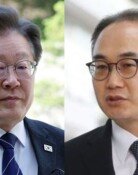Evacuation capital of Korea
Evacuation capital of Korea
Posted January. 10, 2018 08:44,
Updated January. 10, 2018 09:22
In the days of evacuation during the Korean War, Lee Jung-seob lived alone in Busan away from his family. He found housing in Beomil-dong, Dong-gu and travelled downtown to places such as Gwangbok-dong and Gukje Market to make a living and draw pictures. Lee frequented coffee shops in the Gwangbok-dong area. Not being able to afford paint, he drew on the silver paper lining of cigarette packs at the coffee shops. Lee Jung-seob’s masterpieces were born amongst the destitution of refugee-era Busan.
Busan was the provisional capital of South Korea from August 18, 1950, two months following the outbreak of war, through August 15, 1953, when the evacuated government returned to Seoul. South Korean president and bureaucrat politicians, military soldiers and war material suppliers congregated in Busan. As universities were relocated to Busan and intellectuals and artists flocked to Gwangbok-dong, the population of Busan grew from 400,000 to 1 million during the evacuation era. Gukje Market grew rapidly during the period. The Korean War was a defining era for 20th century Busan.
Remnants of evacuation capital Busan have added to the tentative list for UNESCO World Heritage Sites. The Cultural Heritage Administration of Korea recently approved of the eight sites as candidates following an application from the city of Busan. These sites include the Provisional Capital Government Office (Provisional Capitol), Provisional Capital Presidential Residence (Gyeongmudae), Busan Modern History Museum (the American Embassy), Busan Regional Meteorological Administration (National Meteorological Observatory) and the United Nations Memorial Cemetery in Korea. It is the first time that 20th century modern cultural heritage, not a pre-modern relic from historical times leading up to the Joseon Dynasty, has made the UNESCO World Heritage Tentative List. The most notable piece of architecture among the historical sites is Provisional Capital Government Office located in Bumin-dong, adjacent to Gwangbok-dong. Built in 1925 as the Office for South Gyeongsang Province, it was used during the Korean War as the Provisional Government Office. Currently used as Dong-A University Museum, it is considered to be one of the most attractive museums in the country.
The Tentative List is literally tentative. Sites on the list must pass many screening stages to be selected. The Cultural Heritage Administration added conditions to “add heritage that reflects the lives of the refugees and create a plan for preservation and maintenance.” Busan City needs to make an effort to remember the vestiges of the arts and culture of refugee-era Busan, including Lee Jung-seob’s artistic spirit and the coffee shops in Gwangbok-dong.







